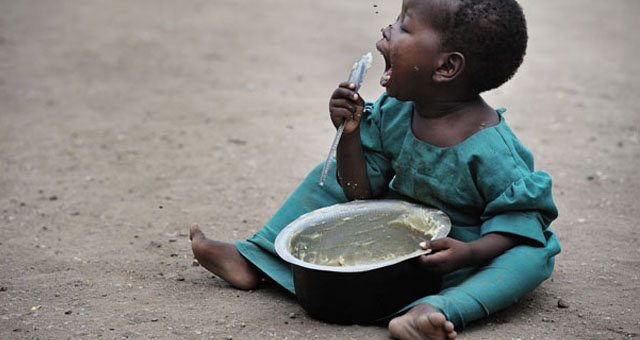United Nations: The number of undernourished people in India has declined by 60 million, from 21.7 per cent of the population in 2004-06 to 14 per cent in 2017-19, according to a UN report.
The State of Food Security and Nutrition in the World report, released Monday, said that there were less stunted children but more obese adults in India.
The report — considered the most authoritative global study tracking progress towards ending hunger and malnutrition — said that the number of undernourished people in India declined from 249.4 million in 2004–06 to 189.2 million in 2017–19.
In percentage terms, the prevalence of undernourishment in the total population in India declined from 21.7 per cent in 2004-06 to 14 per cent in 2017-19, it said.
The two subregions showing reductions in undernourishment — eastern and southern Asia — are dominated by the two largest economies of the continent — China and India.
“Despite very different conditions, histories and rates of progress, the reduction in hunger in both the countries stems from long-term economic growth, reduced inequality, and improved access to basic goods and services,” it said.
The report is prepared jointly by the Food and Agriculture Organisation of the United Nations (FAO), the International Fund for Agricultural Development (IFAD), the United Nations Children’s Fund (UNICEF), the UN World Food Programme (WFP) and the World Health Organization (WHO).
It further said that the prevalence of stunting in children under 5 years of age in India declined from 47.8 per cent in 2012 to 34.7 per cent in 2019 or from 62 million in 2012 to 40.3 million in 2019.
More Indian adults became obese between 2012-16, it said.
The number of adults (18 years and older) who are obese grew from 25.2 million in 2012 to 34.3 million in 2016, from 3.1 per cent to 3.9 per cent.
The number of women of reproductive age (15–49) affected by anaemia grew from 165.6 million in 2012 to 175.6 million in 2016.
The number of infants 0–5 months of age exclusively breastfed grew from 11.2 million in 2012 to 13.9 million in 2019.
The report said that almost 690 million people globally were undernourished (or hungry) in 2019, up by 10 million from 2018.
The hungry are most numerous in Asia, but expanding fastest in Africa.
Across the planet, the report forecasts, that the COVID-19 pandemic could push over 130 million more people into chronic hunger by the end of 2020.
In percentage terms, Africa is the hardest hit region and becoming more so, with 19.1 per cent of its people undernourished.
At the current trends, by 2030, Africa will be home to more than half of the world’s chronically hungry.
The COVID-19 is intensifying the vulnerabilities and inadequacies of global food systems – understood as all the activities and processes affecting the production, distribution and consumption of food.
“While it is too soon to assess the full impact of the lockdowns and other containment measures, the report estimates that at a minimum, another 83 million people, and possibly as many as 132 million, may go hungry in 2020 as a result of the economic recession triggered by COVID-19,” it said, adding that the setback throws into further doubt the achievement of the Sustainable Development Goal two, whose target is achieving zero hunger.
The latest estimates are that a staggering three billion people or more cannot afford a healthy diet.
In sub-Saharan Africa and southern Asia, this is the case for 57 per cent of the population – though no region, including north America and Europe, is spared.
In 2019, 191 million children under five were stunted or wasted – too short or too thin. Another 38 million under-fives were overweight.
Among adults, meanwhile, obesity has become a global pandemic in its own right.
The study calls on the governments to mainstream nutrition in their approaches to agriculture; work to cut cost-escalating factors in the production, storage, transport, distribution and marketing of food – including by reducing inefficiencies and food loss and waste.
It also urges them to support local small-scale producers to grow and sell more nutritious foods, and secure their access to markets; prioritise children’s nutrition as the category in greatest need; foster behaviour change through education and communication.
The report noted that generally, cash transfer programmes are considered an appropriate instrument to increase dietary diversity in well-connected urban or rural contexts, while in-kind transfers are more appropriate for remote areas, where access to markets is severely limited.
“In India, for instance, the country’s Targeted Public Distribution System represents the largest social protection programme in the world, reaching 800 million people with subsidised cereals that can be purchased from more than 500,000 fair price shops across the country.”
In India, rural business hubs have facilitated linking smallholder farmers to rapidly growing urban markets.
Apart from procuring food products from the farmers, these hubs provide services such as farm inputs and equipment, as well as access to credit.
Having food processing, packaging and cooling facilities at the same location allows consumers to benefit from economies of agglomeration and, on the whole, reduce transaction costs throughout the food supply chain.
This model in India has given rise to rural supermarkets that provide cheaper staple food, it added.
(PTI)
